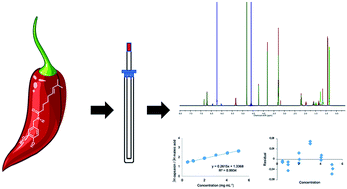Quantification of capsaicinoids from chili peppers using 1H NMR without deuterated solvent
Abstract
Capsaicinoids are widely known for their pharmacological properties and are responsible for flavoring peppers through their pungent aroma. In turn, this pungency can be determined by quantifying the capsaicinoids present in peppers by means of chromatographic and spectroscopic techniques, or sensory analysis such as the Scoville scale. The present research presents a rapid and simple method for capsaicinoid quantification in commercial peppers by way of the relationship between analytes and an internal standard area resulting from 1H NMR analysis without the use of a deuterated solvent solution. Samples were diluted in a mixture of water and methanol, and then compared to a solution of maleic acid in deuterated water. For validation of the method, figures of merit such as selectivity, linearity, detection, and quantification limits, accuracy, precision, and robustness were obtained for capsaicin and dihydrocapsaicin. The presented method exhibits great linearity, with a correlation coefficient (R) of 0.9967, good accuracy for samples with concentration greater than 3 mg mL−1, with an error rate close to 3%, good robustness with minimal variation observed even one month after sample stored, good precision (<1%), and detection and quantification limits from 0.639 mg mL−1 to 2.633 mg mL−1, respectively. In order to evaluate the proposed method and apply it for pungency determination, analyses were performed in commercially acquired samples of Malagueta, Habanero, Bhut Jolokia, Trinidad Scorpion, and Carolina Reaper peppers to assign respective Scoville Heat Unit values.



 Please wait while we load your content...
Please wait while we load your content...